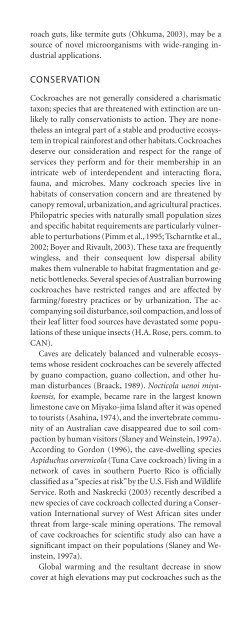Cockroache; Ecology, behavior & history - W.J. Bell
Cockroache; Ecology, behavior & history - W.J. Bell
Cockroache; Ecology, behavior & history - W.J. Bell
You also want an ePaper? Increase the reach of your titles
YUMPU automatically turns print PDFs into web optimized ePapers that Google loves.
oach guts, like termite guts (Ohkuma, 2003), may be a<br />
source of novel microorganisms with wide-ranging industrial<br />
applications.<br />
CONSERVATION<br />
<strong>Cockroache</strong>s are not generally considered a charismatic<br />
taxon; species that are threatened with extinction are unlikely<br />
to rally conservationists to action. They are nonetheless<br />
an integral part of a stable and productive ecosystem<br />
in tropical rainforest and other habitats. <strong>Cockroache</strong>s<br />
deserve our consideration and respect for the range of<br />
services they perform and for their membership in an<br />
intricate web of interdependent and interacting flora,<br />
fauna, and microbes. Many cockroach species live in<br />
habitats of conservation concern and are threatened by<br />
canopy removal, urbanization, and agricultural practices.<br />
Philopatric species with naturally small population sizes<br />
and specific habitat requirements are particularly vulnerable<br />
to perturbations (Pimm et al., 1995; Tscharntke et al.,<br />
2002; Boyer and Rivault, 2003). These taxa are frequently<br />
wingless, and their consequent low dispersal ability<br />
makes them vulnerable to habitat fragmentation and genetic<br />
bottlenecks. Several species of Australian burrowing<br />
cockroaches have restricted ranges and are affected by<br />
farming/forestry practices or by urbanization. The accompanying<br />
soil disturbance, soil compaction, and loss of<br />
their leaf litter food sources have devastated some populations<br />
of these unique insects (H.A. Rose, pers. comm. to<br />
CAN).<br />
Caves are delicately balanced and vulnerable ecosystems<br />
whose resident cockroaches can be severely affected<br />
by guano compaction, guano collection, and other human<br />
disturbances (Braack, 1989). Nocticola uenoi miyakoensis,<br />
for example, became rare in the largest known<br />
limestone cave on Miyako-jima Island after it was opened<br />
to tourists (Asahina, 1974), and the invertebrate community<br />
of an Australian cave disappeared due to soil compaction<br />
by human visitors (Slaney and Weinstein, 1997a).<br />
According to Gordon (1996), the cave-dwelling species<br />
Aspiduchus cavernicola (Tuna Cave cockroach) living in a<br />
network of caves in southern Puerto Rico is officially<br />
classified as a “species at risk”by the U.S. Fish and Wildlife<br />
Service. Roth and Naskrecki (2003) recently described a<br />
new species of cave cockroach collected during a Conservation<br />
International survey of West African sites under<br />
threat from large-scale mining operations. The removal<br />
of cave cockroaches for scientific study also can have a<br />
significant impact on their populations (Slaney and Weinstein,<br />
1997a).<br />
Global warming and the resultant decrease in snow<br />
cover at high elevations may put cockroaches such as the<br />
New Zealand alpine species Celatoblatta quinquemaculata<br />
at risk (Sinclair, 2001). Although the species is physiologically<br />
protected against the cold, it relies on the thermal<br />
buffering effect of snow cover in particularly harsh<br />
winters. Reduced snow cover results in an increased number<br />
of freeze-thaw cycles and lower absolute minimum<br />
temperatures, making the “mild” winter more, rather<br />
than less, stressful to the insect.<br />
Wood-feeding and other log-dependent cockroaches<br />
(Table 3.2) are sensitive to the ecological changes brought<br />
about by both modern forestry and human settlement<br />
and, like many saproxylic arthropods (Grove and Stork,<br />
1999; Schiegg, 2000), may be used as habitat continuity<br />
indicators in ecological assessment. These insects rely on<br />
a resource whose removal from the ecosystem is the usual<br />
objective of forest management (Grove and Stork, 1999)<br />
and compete with lumber companies (Cleveland et al.,<br />
1934) and resident humans who prize coarse woody debris<br />
as fuel and building material. Wood-feeding cockroaches<br />
may survive canopy removal and subsequent desiccating<br />
conditions if logs of a size sufficient to provide a<br />
suitable microhabitat are left on the ground. Cryptocercus<br />
primarius, for example, has been collected from largediameter<br />
logs in young re-growth forest in China (Fig.<br />
10.5). More often, however, coarse woody debris left on<br />
the forest floor after logging operations is gathered and<br />
used as fuel (Nalepa et al., 2001b). Based on the work of<br />
Harley Rose (University of Sydney), the endemic Lord<br />
Howe Island wood-feeding cockroach Panesthia lata was<br />
recently listed by the New South Wales Scientific Committee<br />
as an endangered species (Adams, 2004). It has not<br />
been found on Lord Howe Island since the 1960s, probably<br />
because of rats introduced in 1918. Small numbers of<br />
the cockroach were recently discovered on Blackburn Island<br />
and Roach Island.<br />
Litter-dwelling cockroaches can be sensitive habitat indicators.<br />
The Russian cockroach Ectobius duskei, normally<br />
found at levels of up to 10 individuals/m 2 in undisturbed<br />
steppe, disappears if these grasslands are plowed<br />
to grow wheat. If the fields are allowed to lie fallow, the<br />
cockroaches gradually become reestablished (Bei-Bienko,<br />
1969, 1970). Although the species has been eliminated in<br />
intensely cultivated areas, a 1999 study found E. duskei<br />
well represented in the leaf litter of steppe meadows in the<br />
Samara district (Lyubechanskii and Smelyanskii, 1999).<br />
The effect of disturbance on litter invertebrates depends<br />
not only on the type of disturbance, but also on<br />
site-specific factors. In the dry Mediterranean-type climate<br />
of western Australia cockroaches appear resilient to<br />
moderate disturbances. Cockroach numbers and species<br />
richness as measured by pitfall traps declined significantly<br />
after logging and fire, yet recovered within 48 mon.<br />
ECOLOGICAL IMPACT 173


